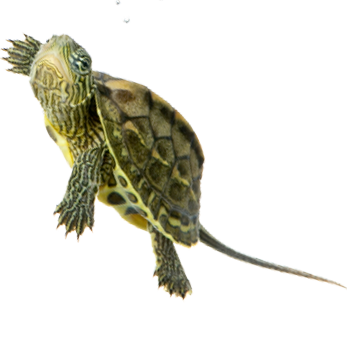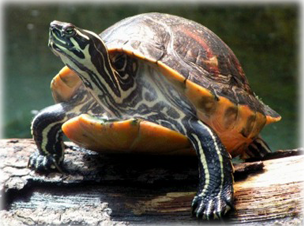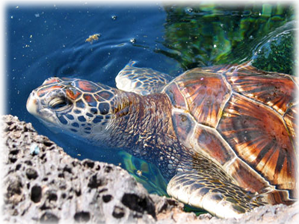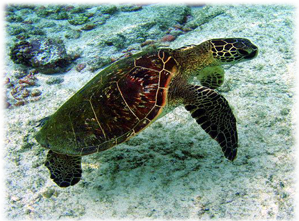 Sea Turtles are almost always submerged but breathe air. With a single explosive exhalation and rapid inhalation, sea turtles can quickly refill their lungs when they are on the surface. Their lungs have adapted to permit rapid exchange of oxygen and to avoid trapping gases during deep dives. Turtles can rest or sleep underwater for several hours at a time but submergence time is much shorter while hunting or to escape predators. Activity and stress affect breath-holding ability, which is why turtles drown in shrimp trawls and other fishing gear within a relatively short time. Turtles must emerge while breeding, given the extra level of activity. The lifespan of sea turtles is 80 years.
After about 3 years of maturing, adult female sea turtles return to land to nest at night. Different species of sea turtles exhibit various levels of philopatry. In the extreme case, females return to the beach where they hatched. This can take place every two to four years in maturity. They make from one to eight nests per season.
The mature nesting female hauls herself onto the beach and finds suitable sand on which to create a nest. Using her hind flippers, she digs a circular hole 16 to 20 in deep. After the hole is dug, the female then starts filling the nest with a clutch of soft-shelled eggs one by one until she has deposited around 50 to 200 eggs, depending on the species. Some species have been reported to lay 250 eggs like hawksbill. After laying, she re-fills the nest with sand, re-sculpting and smoothing the surface until it is relatively undetectable visually. The whole process takes thirty to sixty minutes. She then returns to the ocean, leaving the eggs untended.
Incubation takes about two months. The eggs in one nest hatch together over a very short period of time. When ready, hatchlings tear their shells apart with their snout and dig through the sand. Once they reach the surface, they instinctively head towards the sea.
Sea Turtles are almost always submerged but breathe air. With a single explosive exhalation and rapid inhalation, sea turtles can quickly refill their lungs when they are on the surface. Their lungs have adapted to permit rapid exchange of oxygen and to avoid trapping gases during deep dives. Turtles can rest or sleep underwater for several hours at a time but submergence time is much shorter while hunting or to escape predators. Activity and stress affect breath-holding ability, which is why turtles drown in shrimp trawls and other fishing gear within a relatively short time. Turtles must emerge while breeding, given the extra level of activity. The lifespan of sea turtles is 80 years.
After about 3 years of maturing, adult female sea turtles return to land to nest at night. Different species of sea turtles exhibit various levels of philopatry. In the extreme case, females return to the beach where they hatched. This can take place every two to four years in maturity. They make from one to eight nests per season.
The mature nesting female hauls herself onto the beach and finds suitable sand on which to create a nest. Using her hind flippers, she digs a circular hole 16 to 20 in deep. After the hole is dug, the female then starts filling the nest with a clutch of soft-shelled eggs one by one until she has deposited around 50 to 200 eggs, depending on the species. Some species have been reported to lay 250 eggs like hawksbill. After laying, she re-fills the nest with sand, re-sculpting and smoothing the surface until it is relatively undetectable visually. The whole process takes thirty to sixty minutes. She then returns to the ocean, leaving the eggs untended.
Incubation takes about two months. The eggs in one nest hatch together over a very short period of time. When ready, hatchlings tear their shells apart with their snout and dig through the sand. Once they reach the surface, they instinctively head towards the sea.
Fun Facts
Like other reptiles, the sea turtle ear has a single bone in the middle ear that conducts vibrations to the inner ear. Researchers have found that sea turtles respond to low frequency sounds and vibrations. Sea turtles can see well under water but are shortsighted in the air. Under experimental condititons, loggerhead and green sea turtle hatchlings exhibited a preference for near-ultraviolet, violet, and blue-green ligh. Little is known about a sea turtle's sense of taste. Most researchers believe that sea turtles have an acute sense of smell in the water. Experiments show that hatchlings react to the scent of shrimp. This adaptation allows sea turtles to locate food in murky water. Sea turtles open their mouths slightly and draw in water through the nose, then immediately empty it out again throught the mouth. Pulsating movements of the throat are thought to be associated with smelling. Sea turtles are not generally considered social animals; however, some species do congregate offshore. Sea turtles do gather together to mate. Members of some species travel together to nesting grounds. After hatchlings reach the water they generally remain solitary until they mate.
 Sea Turtles are almost always submerged but breathe air. With a single explosive exhalation and rapid inhalation, sea turtles can quickly refill their lungs when they are on the surface. Their lungs have adapted to permit rapid exchange of oxygen and to avoid trapping gases during deep dives. Turtles can rest or sleep underwater for several hours at a time but submergence time is much shorter while hunting or to escape predators. Activity and stress affect breath-holding ability, which is why turtles drown in shrimp trawls and other fishing gear within a relatively short time. Turtles must emerge while breeding, given the extra level of activity. The lifespan of sea turtles is 80 years.
After about 3 years of maturing, adult female sea turtles return to land to nest at night. Different species of sea turtles exhibit various levels of philopatry. In the extreme case, females return to the beach where they hatched. This can take place every two to four years in maturity. They make from one to eight nests per season.
The mature nesting female hauls herself onto the beach and finds suitable sand on which to create a nest. Using her hind flippers, she digs a circular hole 16 to 20 in deep. After the hole is dug, the female then starts filling the nest with a clutch of soft-shelled eggs one by one until she has deposited around 50 to 200 eggs, depending on the species. Some species have been reported to lay 250 eggs like hawksbill. After laying, she re-fills the nest with sand, re-sculpting and smoothing the surface until it is relatively undetectable visually. The whole process takes thirty to sixty minutes. She then returns to the ocean, leaving the eggs untended.
Incubation takes about two months. The eggs in one nest hatch together over a very short period of time. When ready, hatchlings tear their shells apart with their snout and dig through the sand. Once they reach the surface, they instinctively head towards the sea.
Sea Turtles are almost always submerged but breathe air. With a single explosive exhalation and rapid inhalation, sea turtles can quickly refill their lungs when they are on the surface. Their lungs have adapted to permit rapid exchange of oxygen and to avoid trapping gases during deep dives. Turtles can rest or sleep underwater for several hours at a time but submergence time is much shorter while hunting or to escape predators. Activity and stress affect breath-holding ability, which is why turtles drown in shrimp trawls and other fishing gear within a relatively short time. Turtles must emerge while breeding, given the extra level of activity. The lifespan of sea turtles is 80 years.
After about 3 years of maturing, adult female sea turtles return to land to nest at night. Different species of sea turtles exhibit various levels of philopatry. In the extreme case, females return to the beach where they hatched. This can take place every two to four years in maturity. They make from one to eight nests per season.
The mature nesting female hauls herself onto the beach and finds suitable sand on which to create a nest. Using her hind flippers, she digs a circular hole 16 to 20 in deep. After the hole is dug, the female then starts filling the nest with a clutch of soft-shelled eggs one by one until she has deposited around 50 to 200 eggs, depending on the species. Some species have been reported to lay 250 eggs like hawksbill. After laying, she re-fills the nest with sand, re-sculpting and smoothing the surface until it is relatively undetectable visually. The whole process takes thirty to sixty minutes. She then returns to the ocean, leaving the eggs untended.
Incubation takes about two months. The eggs in one nest hatch together over a very short period of time. When ready, hatchlings tear their shells apart with their snout and dig through the sand. Once they reach the surface, they instinctively head towards the sea.




